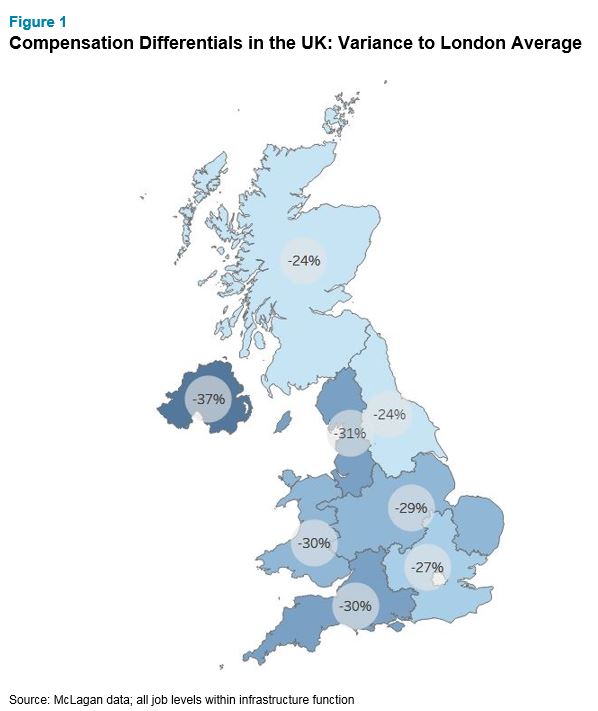As remote work becomes the new reality, companies across Europe are assessing geographic pay differentials and the impact of location strategy on total rewards.

Although firms across Europe and the rest of the world are still coming to terms with the shock that the COVID-19 pandemic has caused to supply chains, operating structures and what used to be considered “business as usual,” there is light at the end of the tunnel. According to Aon’s most recent COVID-19 pulse study, 66% of European companies reported that they were in the recovery stage of Aon’s crisis management model — described as planning around returning to the workplace, updating business goals and adjusting operating models.
When addressing these inevitable changes, most firms are grappling with what the future of work will look like, which has been pushed to the forefront significantly sooner than anyone had formerly anticipated. The pandemic has clearly accelerated business planning around utilising alternative locations and flexible/remote work arrangements, and the resulting impact on both rewards governance and financial planning. Our latest pulse survey revealed that 53% of European firms plan to provide eligible employees with ongoing flexibility to work in the office or remain virtual as needed. Decisions made now will undoubtedly have a long-lasting effect on employer brand, employee value proposition and company financial performance for years to come. We discuss this further for the European technology sector in our recently published article: As European Technology Firms Consider a More Virtual Workforce, They Must Decide How Location Factors Into Pay.
To achieve success in the current environment, firms must assess their location strategy at a macro level, explore new markets for talent and revisit site organisation structures within their existing footprint. Here are some key points to consider along the journey.
The Business Impact of Location
Location has always been an important consideration, whether you are a large, full-service global financial institution, or a smaller regional bank focused on select lines of business or geography. The decisions leadership make have a lasting impact, not only on the quality of hired talent, but also on the cost of talent (and resulting bottom line). Our analysis of top European banks finds that compensation and benefits (C&B) can account for upwards of 50% of operating expenses, with an additional 10-20% attributed to infrastructure costs. The forced shift to remote work has created new opportunities for companies to cut costs, while also re-appraising their employee value proposition and employer brand.
Moving a large portion of the workforce to a work-from-home model represents a significant modification that requires careful planning in multiple business facets to ensure that the desired outcome is achieved. Here are the different elements of human capital planning to consider:
Adjustments to total rewards
As firms consider such a substantial change, they must also take into account how this will impact total rewards for all employees, especially those that may be moving from higher-cost locations to lower-cost locations. Historically speaking, the most common approach to geographic differentiation is to adjust pay based on an employee’s office location, with ranges or trending factors applied for major metropolitan areas. If employees move out of high-cost locations, such as London, to lower cost centres or rural areas, employers must think about how they adjust compensation for these employees, as well as those who transition from the traditional office to flexible and remote working arrangements going forward.
Supplemental market data informs geographic pay differentials
At the heart of these decisions is the individual company’s rewards philosophy. Cost of labour and cost of living are two main considerations when making adjustments to an employee’s salary. For a highly competitive and performance-driven industry, such as financial services, it is important that firms utilise data focusing on cost of labour, with less consideration towards cost of living. To explore this further, we are actively conducting regression analysis using our McLagan survey data for financial services companies to identify where statistically significant pay differentials exist, focusing on the arbitrage between regions and cities. Early analysis reveals that these variances are most apparent in functions where market competition is fierce — mostly at intermediate and junior levels, with less impact at the senior level.
This approach ensures that differences are market driven and not skewed by a small group of a firm’s location strategy or demographics of the underlying population. Such differentials can be used alongside national market data, providing a strong foundation for setting a formulaic approach to fixed pay adjustments for agile workers.

Increased competition for talent
A flexible workforce means that companies will compete with many non-traditional peers for talent. Infrastructure roles with fungible and translatable skills (e.g., technology, operations, HR and finance) that are more prepared for a flexible or remote working arrangement may consider transitioning to new locations where their skillsets are finite and in higher demand. Confirming that these individuals are paid competitively will ensure that key employees are retained without any systematic attrition. Several factors, such as how adjustments will be made (e.g., salary adjustments, allowances, variable pay), whether the move was initiated by the company or the employee and the determined timeframe for working from home (e.g., temporary, permanent, flexible) should also be considered, with flexibility built into the governance structure to avoid any adverse effects on the population.
Next Steps
The assessment of your firm’s global location strategy can unlock additional savings greater than any other adjustments related to the move towards more agile working arrangements. Multinational companies have generally looked towards Eastern Europe (Poland, Czech Republic and Romania) and Asia (India and Philippines) for lower cost talent. Additional savings and stability can be recognized by doing a deeper dive on the availability and cost differentials for specific skillsets across Europe. The pandemic has shown the importance of proper diversification of functions and locations, exposing operational risks due to regional closures and lockdowns in centres where certain functions are performed. Assessing not only where the highest availability of eligible talent is located, but also the diversification of which functions and roles are in each location can minimize operational risk and the impact of future macroeconomic events. Throughout the process, it’s important to utilize market data to inform decisions around the size and cost of the local labour market, the availability of specific skills and degrees, market competitiveness and the organisational design for each “centre of excellence” in a specific region.
To learn more about location strategy or to speak with a member of our rewards consulting group, please write to rewards-solutions@aon.com.
To read more articles on how rewards professionals can respond to the COVID-19 pandemic, please click here.
COVID-19 Disclaimer: This document has been provided as an informational resource for Aon clients and business partners. It is intended to provide general guidance on potential exposures, and is not intended to provide medical advice or address medical concerns or specific risk circumstances. Due to the dynamic nature of infectious diseases, Aon cannot be held liable for the guidance provided. We strongly encourage visitors to seek additional safety, medical and epidemiologic information from credible sources such as the Centers for Disease Control and Prevention and World Health Organization. As regards insurance coverage questions, whether coverage applies or a policy will respond to any risk or circumstance is subject to the specific terms and conditions of the insurance policies and contracts at issue and underwriter determinations.
General Disclaimer: The information contained in this article and the statements expressed herein are of a general nature and not intended to address the circumstances of any particular individual or entity. Although we endeavor to provide accurate and timely information and use sources we consider reliable, there can be no guarantee that such information is accurate as of the date it is received or that it will continue to be accurate in the future. No one should act on such information without the appropriate professional advice after a thorough examination of the particular situation.